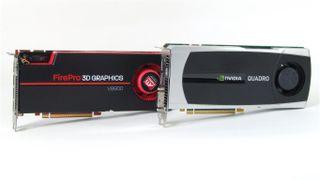Workstation Shootout: Nvidia Quadro 5000 Vs. ATI FirePro V8800
Nvidia sure didn't waste any time introducing its Fermi architecture to the workstation space. Its Quadro 5000 is one of the first models to use the company's GF100 graphics processor. How does this card stack up against ATI’s flagship FirePro V8800?

Introduction
The first half of this year felt like Nvidia was taking a time-out or a nap, leaving both its third-party board vendors and customers impatient (BFG, of course, paid the ultimate price). It seemed the company was content to keep creatively renaming its desktop graphics chips, and thus sticking with its then-current portfolio.
Meanwhile, AMD launched its entire line of DirectX 11-compatible Radeon HD 5000-series cards, literally from top to bottom.
Finally, after several delays, Nvidia brought its own DirectX 11 GPU to market, officially called GF100 and based on the Fermi architecture.

The first cards to employ the new design were called the GeForce GTX 480, GeForce GTX 470, and GeForce GTX 465, and all of them were aimed at the gaming enthusiast. Now, Nvidia is introducing a workstation-class card belonging to the Quadro line. Again, AMD enjoys a bit of a lead here as well, having already updated its FirePro line of professional graphics cards in late spring.
That sets the stage for today’s comparison in which we will pit Nvidia’s new Quadro 5000 against AMD's flagship ATI FirePro V8800, comparing both cards to previous-generation parts as well. Since some of our readers may not be familiar with workstation graphics, allow us to provide a frame of reference by comparing them to their mainstream gaming brethren.
The Quadro 5000 is based on Nvidias GF100 GPU and contains 352 shader cores, making it more or less a twin of the GeForce GTX 465. The main differences between the two relate to the memory subsystem and the clock frequencies. AMD's FirePro V8800 is built around the company's Cypress XT (RV870), the same GPU powering its Radeon HD 5870.
So, going into this comparison, what should our expectations be? Comparisons between the gaming versions of these cards show them going head-to-head in many cases, with AMD taking the lead in some cases and Nvidia in others, depending on the game, benchmark, and settings. In the past, this sort of pattern has translated quite well into the workstation world. Will this hold true here as well, or will we see a clear winner emerge?
Stay on the Cutting Edge
Join the experts who read Tom's Hardware for the inside track on enthusiast PC tech news — and have for over 25 years. We'll send breaking news and in-depth reviews of CPUs, GPUs, AI, maker hardware and more straight to your inbox.
When it unveiled its Fermi architecture, Nvidia repeatedly stressed that this design was not developed expressly for the gaming market. Instead, the company strove to create a design that could also target the workstation segment, as well as HPC markets. Today‘s test will also show whether Nvidia achieves this goal.
Before we dive into the benchmarks, we’ll take a closer look at the contenders, sizing up Nvidia’s Quadro 5000 and the ATI FirePro V8800. We’ll also consider their respective fields.
-
tacoslave if amd put a little more work on their drivers (i.e crossfire and firepro performance)they would be the clear performance champion.Reply -
Gin Fushicho I really wish I knew what these numbers meant.Reply
For someone who doesn't do 3-D design these benchmarks are kinda confusing. -
joytech22 You need to remember, Fermi is designed not "Just" for games, but was also designed, from day one, with computing in mind as well.Reply -
SchizoFrog Once again the arguement regarding AMD Drivers is brought to the fore. But more than this, when AMD has a line of products that could be said to 'miss' they absolutely FAIL. nVidia on the otherhand seem to have learned their lesson well from the 5xxxFX series and can still produce products that can compete at least at some level, ie: GTX460. Although these are Workstation products, nVidia have a complete package with GPUs and Drivers that work from the off.Reply -
davefb sort of interesting, but why is there no comparison to mainstream boards? There is a massive premium of cost here but nothing to be able to say 'hey boss, the onboard graphics we use really don't cut it any more, how about a quadro'.Reply
(or have I sped-read past the reason why ;) )

